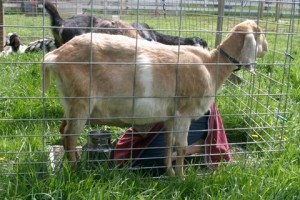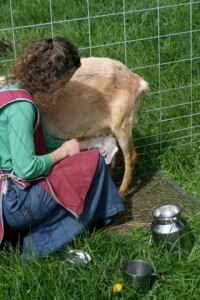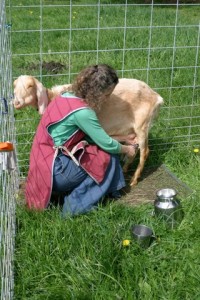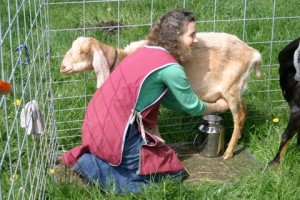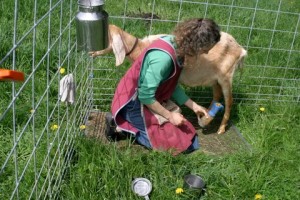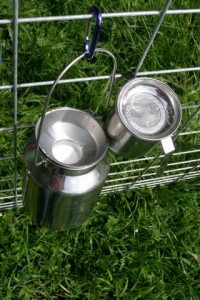Here is a quick roundup of how our milking routine works. Kathy has gone through several different routines, and this one is working well for us.
Since our goats are enclosed in portable pens, we actually go out to the pen to milk instead of moving the goat. The ground is often bumpy, so we use a 2 ft x 4 ft piece of expanded metal as the “stand”. This gives a nice flat area to work on, and is a great help in preventing the milk bucket from tipping over.
Each goat has a collar which we clip directly to the wall of the pen keeping them in one place during the milking. Depending on weather and other factors, this may be a good time to brush off the coat of the milker and knock off any loose hair or hay stubble before you start.
First, we wash off the udder with warm, almost hot water. Since we only have a few goats to milk, it works to take a small container of hot water out to the pen with us–it stays warm long enough to last through all the goats. Each doe gets a clean washcloth, and the cloth should not got back into the water a 2nd time.
The first milk that comes out of the teat has the highest concentration of bacteria in it. These aren’t necessarily pathogenic bacteria, but they will cause the milk to sour more quickly, or give it a stronger flavor. By sending the first few squirts into a strip cup, it helps to flush these out of the milk pathway. The top of the strip cup is covered with a fine mesh. If the milk does not pass cleanly through the mesh, there is a problem with the goat–indicating a need for further mastitis or health checks.
Now that the udder is clean and the first milk has been cleared out, it’s time to collect the milk. We have a filter that fits neatly onto the top of our milking pail–it’s really a stainless funnel with a screw on ring. it has a special fiber filter that is held in place by the ring. (It’s called a stainless steel mini-strainer) This keeps any surprise objects out – often a couple hairs of blades of grass will try to jump in. A goat can produce anywhere from 2 cups to 2 quarts per milking. We’ve found that 1 quart per day is the normal production for our grass & browse fed nubians.
Sometimes the goat will “dance” as you milk her. There are many reasons why this may happen, and you will want to pay attention to see why. It may be that she is in pain because of a problem, or she doesn’t want you to finish her off before her goat kids get their share, or she is just impatient to move on. Prevent “bucket failure” by the pail handle away from the goat’s dancing rear feet. Sometimes I’ll hold the pail in one hand and milk with the other as we discuss which of us is the more stubborn.
Last is the teat dip. Milking is a process that stretches out the teat’s orifices, and can leave the opportunity for bacteria to enter and infect the udder. We do an iodine based teat dip at the very end to help prevent hitting problems the next day. This goes into a special squeeze bottle that is made for this job.
Most of our milking equipment we bought from Hoeggers’ Goat Supply. They can be found online at http://hoeggergoatsupply.com/
The 4 & 6 quart stainless steel milk totes are about the right size to fit under our goats. The “stainless steel mini strainer” fits into the top of the tote after you cut off the bottom of the strainer’s handle with a hack saw.
A 100-count box of 6-1/2″ round filters cut into quarters will give you filters for 400 milkings.

